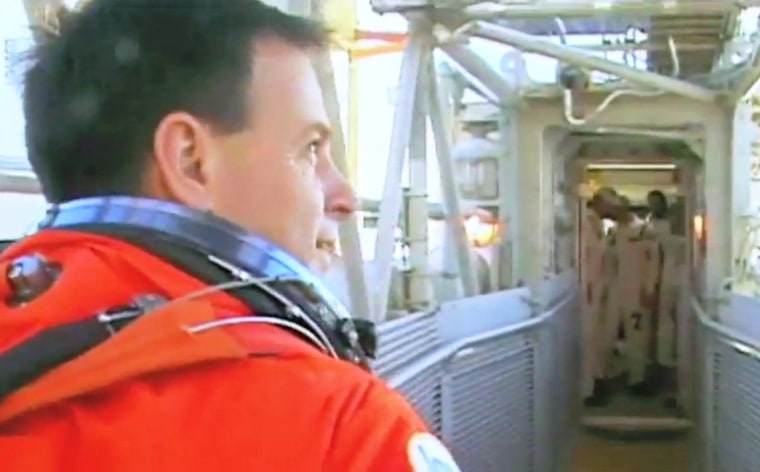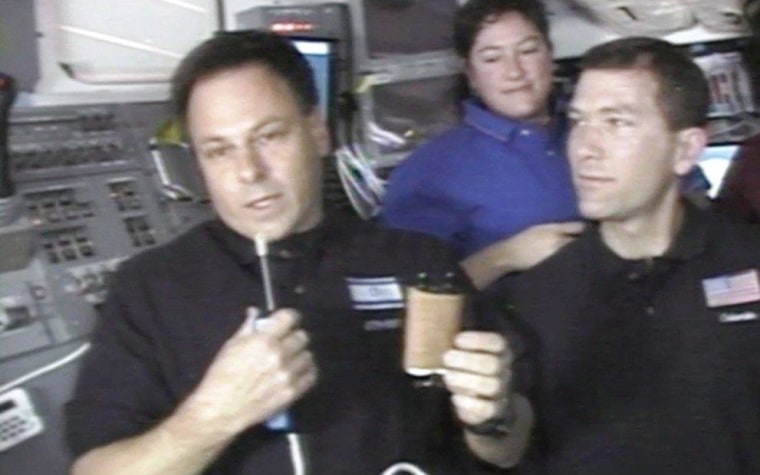"Space Shuttle Columbia: Mission of Hope" puts a fresh spin on the 10-year-old story, turning the tragic loss of Columbia and its crew into an uplifting tale of the human spirit. How does the hourlong TV documentary, premiering Thursday night on PBS stations, pull that off? By focusing on one of the Columbia tragedy's casualties, Israeli astronaut Ilan Ramon — and his connections to an even bigger tragedy, the Nazi Holocaust.
The tale's crucial pivot point is a miniature Jewish Torah scroll that was treasured by a survivor of the Bergen-Belsen concentration camp in Germany: Ramon brought the scroll with him on the ill-fated mission, as a symbol of endurance. Even though the scroll was lost in the Columbia's catastrophic breakup in the skies over Texas on Feb. 1, 2003, its symbolism endures, thanks to "Mission of Hope."
"The film is not about the Columbia accident," director Daniel Cohen told NBC News. "The film is about a journey of hope. When I first started making the film, I thought I was making a documentary about the Holocaust. Then I peeled back the top layers and started to look inside, and I said, 'Wait a minute — there's a lot going on inside the story.'"
Let's start with the sacred scroll: During a death-camp bar mitzvah, the scroll was given to a teenager named Joachim "Yoya" Joseph at Bergen-Belsen by the chief rabbi of Amsterdam, a fellow prisoner at the camp. The rabbi didn't survive, but Joseph did, and the Torah held a place of honor in Joseph's office when he grew up to become an Israeli space scientist.
Ramon, a decorated Israeli combat pilot, also had a Holocaust connection. His mother was a survivor of the Auschwitz concentration camp. But his connection with Joseph came in a different context: After Ramon's selection to be Israel's first astronaut, he worked with Joseph on an experiment to analyze the distribution of airborne dust over the Mediterranean and Middle East regions. Ramon noticed the scroll in Joseph's office, and asked if he could take it with him on his spaceflight.
Joseph's experiment flew on Columbia — and so did his scroll. During one of the mission's downlinks, Ramon showed off the palm-sized treasure and told Joseph's story. "This Torah scroll was given by a rabbi to a young, scared, thin, 13-year-old boy in Bergen-Belsen," Ramon said. "It represents more than anything the ability of the Jewish people to survive. It represents their ability to go from black days, from periods of darkness, to reach periods of hope and faith in the future."


Unfortunately, Feb. 1, 2003, was a black day. The shuttle broke up into pieces during its descent, killing Ramon and the rest of Columbia's crew: Rick Husband, William McCool, Mike Anderson, Laurel Clark, Kalpana Chawla and David Brown. Investigators determined that a piece of foam insulation that flew off Columbia's fuel tank did undetected damage to the leading edge of Columbia's left wing during launch. Sixteen days after liftoff, as the mission was ending, the hot gases of atmospheric re-entry blasted through the breach and destroyed the shuttle from the inside.
Ramon's remains were recovered and returned to Israel. Searchers even recovered the diary that he kept during the flight. But Joseph's little Torah scroll was never found. Cohen, a self-avowed space nut, said he followed the Columbia coverage closely — and took notice of a news item "buried in the back of the newspaper about this little Torah scroll that Ilan carried with him."
"I thought, wow, what a powerful new way to tell a Holocaust story to a new generation," Cohen said. He got in touch with Joseph, and over the course of several years, the filmmaker pieced together the story.
Joseph appears in the movie, although he passed away during post-production and never saw the finished product. "Mission of Hope" also draws upon interviews with Ramon's widow, Rona, as well as with Israeli investigators and former Prime Minister Shimon Peres. Candid footage of the Columbia crew's training, shot by Brown, adds a personal touch to the work.
"The overriding message of the Columbia crew ... is what they brought to each other because of their diverse background," Cohen said. "They brought the magic of diversity to each other, yet woven through that is this story of the Holocaust and this terrible tragedy."
As he gathered the footage and the interviews, Cohen struggled with a problem: He wanted to focus on the message of hope, but it seemed as if the final chapter of the story was filled with loss and despair. "The dilemma was, how do you end this film?" he said.
Then he heard that another miniature Torah scroll had surfaced, in the possession of Henry Fenichel, another survivor of the Bergen-Belsen death camp who became a physics professor in Cincinnati. Fenichel was willing to have the scroll flown aboard another space shuttle flight, at the request of Rona Ramon and under the care of Canadian astronaut Steve MacLean.
"I thought, you just ended my film for me," Cohen said.
The "Atlantis Torah" flew aboard the shuttle Atlantis in 2006, on the first space station assembly mission planned in the wake of the Columbia tragedy. "It goes from the depths of despair to the heights of hope," MacLean told reporters.
More than six decades earlier, when Joseph received his "Columbia Torah," the rabbi who gave it to him asked the boy to promise he'd tell the story of the scroll if he survived.
"Now our documentary continues the promise," Cohen said. "Woven into that is our mission to tell the story of Columbia's crew and their missions. On the 10th anniversary, we will all pause and remember the horror of the moment, a searing moment in history. But at the same time, we'll remember who these people were, and what they brought to us."
More about the Columbia tragedy:
- Columbia remembered, 10 years after launch
- Special report on the shuttle Columbia's loss
- Flash interactive: NASA's Day of Remembrance
Alan Boyle is NBCNews.com's science editor. Connect with the Cosmic Log community by "liking" the log's Facebook page, following @b0yle on Twitter and adding the Cosmic Log page to your Google+ presence. To keep up with Cosmic Log as well as NBCNews.com's other stories about science and space, sign up for the Tech & Science newsletter, delivered to your email in-box every weekday. You can also check out "The Case for Pluto," my book about the controversial dwarf planet and the search for new worlds.